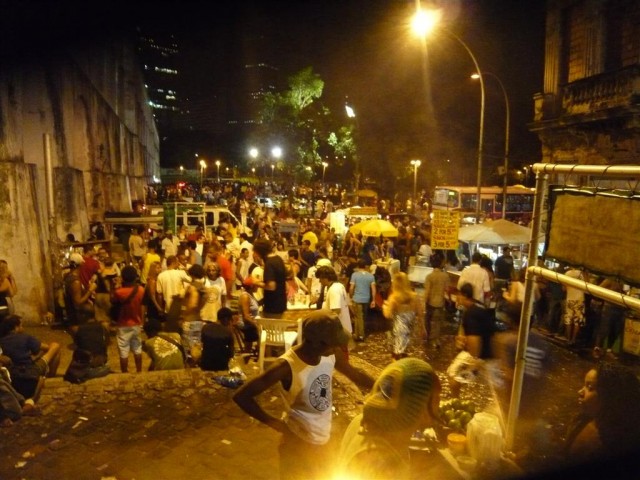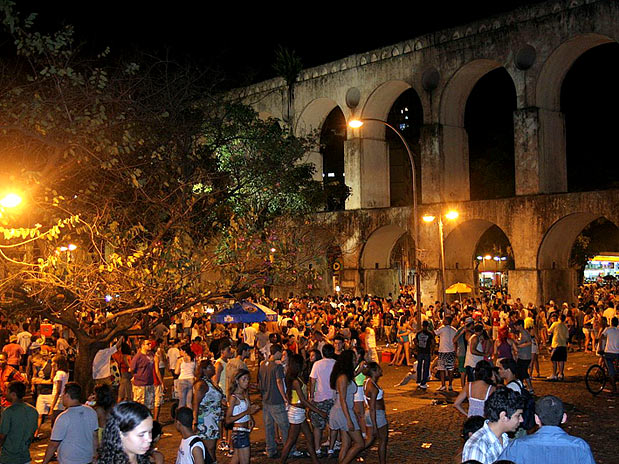Blog July 30, 2012
Rio Journal: Samba, the New Class
As part of our Hip Deep programming, we sent Afropop producer Marlon Bishop to Rio De Janeiro to produce a two-part radio documentary series about the history of samba in Brazil’s iconic city by the bay. Read about his experiences doing research for the program here on the blog.
The central topic of the show Rio 2: Samba Strikes Back is how samba surged Rio in the ‘90s and ‘00s after being largely forgotten by the middle class in the ‘80s, when young people turned towards rock and international styles. One face of this samba revival was a strong interest in roots samba – what they call samba de raiz – centered around the downtown neighborhood of Lapa.
In the 2000s, Lapa went from a largely derelict neighborhood full of crumbling old buildings to a popping nightlife destination, largely powered by a new generation of samba singers and composers who began to perform in its bars and cafes. Many of the musicians that came out of the so-called “Lapa scene” didn’t grow up in the working-class North Zone, where appreciation for the samba roda, or jam, is a longstanding tradition passed down through the generations. Many of them grew up in that middle-class, rock and roll generation, and found their way to samba through other means.
 However they got to samba, the new generation has been a big part of reviving the music the way it was played traditionally: on cavaquinho (the tiny steel-stringed samba ukulele), 7-string guitar, pandeiro (the tambourine-shaped samba drum), along with other percussion instruments, as well as composing new sambas within that format. Here are just a few of the faces from samba’s new class:
Alfredo Del-Penho
Alfredo Del-Penho, 31, is one of the most sought-after composers coming out of the Lapa scene. In our interview, he told me he had very little exposure to samba growing up in nearby Niteroi. He discovered samba when he was 18 and immediately became obsessed. He felt an instant connection to samba, feeling that it was a music that was already deeply inside him, and threw himself into learning the cannon of the great composers. Eventually he began to compose himself.”
“The role of the composer is to photograph the soul of the people and the city, and to make people think about this: What’s happening around me? What is my role in society?,” he said. “Many times we have so much information but we don’t even look around us. Composers look, and see, and write and say this. They print the Brazilian soul in their lyrics.”
Here’s a recording I made of Alfredo playing one of his songs:
Alfredo Song
Teresa Cristina
Teresa was one of the very first musicians to bring samba back to Lapa. She began singing in an café called Semente in 1998, back before the neighborhood was packed with samba-hungry partygoers every Friday night. Composer Pedro Moraes told me he remembered going to see her sing around the year 2000.
“She worked at the agency that registers cars, where you have to go every year and get your license, and was a colleague of a friend of mine,” said Pedro. “My friend took me to watch. She was singing at this natural food restaurant in Lapa, where was deserted back then. No one went there. She was singing to a couple of tables, singing to almost no one. She had an amazing repertoire – the most beautiful repertoire, and people were thrilled because the love for the great songwriters of samba never vanished.”
Since then, Cristina has become a major samba singer in Rio and Brazil. She recorded a few CDs independently, including a tribute to Paulinho da viola, and now has a major-label album out on EMI called Delicada. Here’s a clip from her live DVD:
http://youtu.be/Kasz2aeY-PI
Moyseis Marques
Another important name in the roots samba revival is Moyseis Marques, 33 year-old singer and composer. Moyseis grew up playing MPB and forro, and started a roots samba group called Casuarina around the time that Lapa scene was growing. Check out his beautiful video for his composition “Nomes de Favela,” a minor key samba riffing off the names of Rio’s favelas.
http://youtu.be/VVTOQfgCGiA
Nilze Carvalho
Nilze Carvalho isn’t exactly a young-blood – she’s in her 40s now – but she is a major figure in the samba revival. She was a mandolin prodigy as a child who was already recording and touring by age 11, playing the style instrumental music known as choro. Later, she started her own group called Sururu na Roda and has become a fixture in Lapa. Here’s a video of Nilze singing a homage to Dona Ivone Lara, who I wrote about in a previous post.
http://youtu.be/zgh5sXBlHO4
There’s a documentary in production called “The Heart of Samba” all about this Lapa samba revival scene, directed by Irene Walsh, a singer and filmmaker who has spent a lot of time around that Lapa scene. It looks like it’s going to be fantastic. Check out the trailer here:
http://youtu.be/kCWdqRlVZPo
However they got to samba, the new generation has been a big part of reviving the music the way it was played traditionally: on cavaquinho (the tiny steel-stringed samba ukulele), 7-string guitar, pandeiro (the tambourine-shaped samba drum), along with other percussion instruments, as well as composing new sambas within that format. Here are just a few of the faces from samba’s new class:
Alfredo Del-Penho
Alfredo Del-Penho, 31, is one of the most sought-after composers coming out of the Lapa scene. In our interview, he told me he had very little exposure to samba growing up in nearby Niteroi. He discovered samba when he was 18 and immediately became obsessed. He felt an instant connection to samba, feeling that it was a music that was already deeply inside him, and threw himself into learning the cannon of the great composers. Eventually he began to compose himself.”
“The role of the composer is to photograph the soul of the people and the city, and to make people think about this: What’s happening around me? What is my role in society?,” he said. “Many times we have so much information but we don’t even look around us. Composers look, and see, and write and say this. They print the Brazilian soul in their lyrics.”
Here’s a recording I made of Alfredo playing one of his songs:
Alfredo Song
Teresa Cristina
Teresa was one of the very first musicians to bring samba back to Lapa. She began singing in an café called Semente in 1998, back before the neighborhood was packed with samba-hungry partygoers every Friday night. Composer Pedro Moraes told me he remembered going to see her sing around the year 2000.
“She worked at the agency that registers cars, where you have to go every year and get your license, and was a colleague of a friend of mine,” said Pedro. “My friend took me to watch. She was singing at this natural food restaurant in Lapa, where was deserted back then. No one went there. She was singing to a couple of tables, singing to almost no one. She had an amazing repertoire – the most beautiful repertoire, and people were thrilled because the love for the great songwriters of samba never vanished.”
Since then, Cristina has become a major samba singer in Rio and Brazil. She recorded a few CDs independently, including a tribute to Paulinho da viola, and now has a major-label album out on EMI called Delicada. Here’s a clip from her live DVD:
http://youtu.be/Kasz2aeY-PI
Moyseis Marques
Another important name in the roots samba revival is Moyseis Marques, 33 year-old singer and composer. Moyseis grew up playing MPB and forro, and started a roots samba group called Casuarina around the time that Lapa scene was growing. Check out his beautiful video for his composition “Nomes de Favela,” a minor key samba riffing off the names of Rio’s favelas.
http://youtu.be/VVTOQfgCGiA
Nilze Carvalho
Nilze Carvalho isn’t exactly a young-blood – she’s in her 40s now – but she is a major figure in the samba revival. She was a mandolin prodigy as a child who was already recording and touring by age 11, playing the style instrumental music known as choro. Later, she started her own group called Sururu na Roda and has become a fixture in Lapa. Here’s a video of Nilze singing a homage to Dona Ivone Lara, who I wrote about in a previous post.
http://youtu.be/zgh5sXBlHO4
There’s a documentary in production called “The Heart of Samba” all about this Lapa samba revival scene, directed by Irene Walsh, a singer and filmmaker who has spent a lot of time around that Lapa scene. It looks like it’s going to be fantastic. Check out the trailer here:
http://youtu.be/kCWdqRlVZPo

 However they got to samba, the new generation has been a big part of reviving the music the way it was played traditionally: on cavaquinho (the tiny steel-stringed samba ukulele), 7-string guitar, pandeiro (the tambourine-shaped samba drum), along with other percussion instruments, as well as composing new sambas within that format. Here are just a few of the faces from samba’s new class:
Alfredo Del-Penho
Alfredo Del-Penho, 31, is one of the most sought-after composers coming out of the Lapa scene. In our interview, he told me he had very little exposure to samba growing up in nearby Niteroi. He discovered samba when he was 18 and immediately became obsessed. He felt an instant connection to samba, feeling that it was a music that was already deeply inside him, and threw himself into learning the cannon of the great composers. Eventually he began to compose himself.”
“The role of the composer is to photograph the soul of the people and the city, and to make people think about this: What’s happening around me? What is my role in society?,” he said. “Many times we have so much information but we don’t even look around us. Composers look, and see, and write and say this. They print the Brazilian soul in their lyrics.”
Here’s a recording I made of Alfredo playing one of his songs:
Alfredo Song
Teresa Cristina
Teresa was one of the very first musicians to bring samba back to Lapa. She began singing in an café called Semente in 1998, back before the neighborhood was packed with samba-hungry partygoers every Friday night. Composer Pedro Moraes told me he remembered going to see her sing around the year 2000.
“She worked at the agency that registers cars, where you have to go every year and get your license, and was a colleague of a friend of mine,” said Pedro. “My friend took me to watch. She was singing at this natural food restaurant in Lapa, where was deserted back then. No one went there. She was singing to a couple of tables, singing to almost no one. She had an amazing repertoire – the most beautiful repertoire, and people were thrilled because the love for the great songwriters of samba never vanished.”
Since then, Cristina has become a major samba singer in Rio and Brazil. She recorded a few CDs independently, including a tribute to Paulinho da viola, and now has a major-label album out on EMI called Delicada. Here’s a clip from her live DVD:
http://youtu.be/Kasz2aeY-PI
Moyseis Marques
Another important name in the roots samba revival is Moyseis Marques, 33 year-old singer and composer. Moyseis grew up playing MPB and forro, and started a roots samba group called Casuarina around the time that Lapa scene was growing. Check out his beautiful video for his composition “Nomes de Favela,” a minor key samba riffing off the names of Rio’s favelas.
http://youtu.be/VVTOQfgCGiA
Nilze Carvalho
Nilze Carvalho isn’t exactly a young-blood – she’s in her 40s now – but she is a major figure in the samba revival. She was a mandolin prodigy as a child who was already recording and touring by age 11, playing the style instrumental music known as choro. Later, she started her own group called Sururu na Roda and has become a fixture in Lapa. Here’s a video of Nilze singing a homage to Dona Ivone Lara, who I wrote about in a previous post.
http://youtu.be/zgh5sXBlHO4
There’s a documentary in production called “The Heart of Samba” all about this Lapa samba revival scene, directed by Irene Walsh, a singer and filmmaker who has spent a lot of time around that Lapa scene. It looks like it’s going to be fantastic. Check out the trailer here:
http://youtu.be/kCWdqRlVZPo
However they got to samba, the new generation has been a big part of reviving the music the way it was played traditionally: on cavaquinho (the tiny steel-stringed samba ukulele), 7-string guitar, pandeiro (the tambourine-shaped samba drum), along with other percussion instruments, as well as composing new sambas within that format. Here are just a few of the faces from samba’s new class:
Alfredo Del-Penho
Alfredo Del-Penho, 31, is one of the most sought-after composers coming out of the Lapa scene. In our interview, he told me he had very little exposure to samba growing up in nearby Niteroi. He discovered samba when he was 18 and immediately became obsessed. He felt an instant connection to samba, feeling that it was a music that was already deeply inside him, and threw himself into learning the cannon of the great composers. Eventually he began to compose himself.”
“The role of the composer is to photograph the soul of the people and the city, and to make people think about this: What’s happening around me? What is my role in society?,” he said. “Many times we have so much information but we don’t even look around us. Composers look, and see, and write and say this. They print the Brazilian soul in their lyrics.”
Here’s a recording I made of Alfredo playing one of his songs:
Alfredo Song
Teresa Cristina
Teresa was one of the very first musicians to bring samba back to Lapa. She began singing in an café called Semente in 1998, back before the neighborhood was packed with samba-hungry partygoers every Friday night. Composer Pedro Moraes told me he remembered going to see her sing around the year 2000.
“She worked at the agency that registers cars, where you have to go every year and get your license, and was a colleague of a friend of mine,” said Pedro. “My friend took me to watch. She was singing at this natural food restaurant in Lapa, where was deserted back then. No one went there. She was singing to a couple of tables, singing to almost no one. She had an amazing repertoire – the most beautiful repertoire, and people were thrilled because the love for the great songwriters of samba never vanished.”
Since then, Cristina has become a major samba singer in Rio and Brazil. She recorded a few CDs independently, including a tribute to Paulinho da viola, and now has a major-label album out on EMI called Delicada. Here’s a clip from her live DVD:
http://youtu.be/Kasz2aeY-PI
Moyseis Marques
Another important name in the roots samba revival is Moyseis Marques, 33 year-old singer and composer. Moyseis grew up playing MPB and forro, and started a roots samba group called Casuarina around the time that Lapa scene was growing. Check out his beautiful video for his composition “Nomes de Favela,” a minor key samba riffing off the names of Rio’s favelas.
http://youtu.be/VVTOQfgCGiA
Nilze Carvalho
Nilze Carvalho isn’t exactly a young-blood – she’s in her 40s now – but she is a major figure in the samba revival. She was a mandolin prodigy as a child who was already recording and touring by age 11, playing the style instrumental music known as choro. Later, she started her own group called Sururu na Roda and has become a fixture in Lapa. Here’s a video of Nilze singing a homage to Dona Ivone Lara, who I wrote about in a previous post.
http://youtu.be/zgh5sXBlHO4
There’s a documentary in production called “The Heart of Samba” all about this Lapa samba revival scene, directed by Irene Walsh, a singer and filmmaker who has spent a lot of time around that Lapa scene. It looks like it’s going to be fantastic. Check out the trailer here:
http://youtu.be/kCWdqRlVZPo










